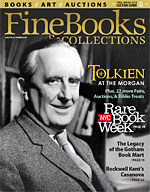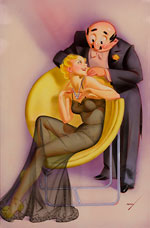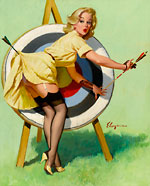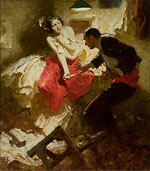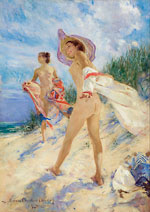The Pin-Up King
A Collection of Cuties Goes Under the Hammer By Jonathan Shipley
It started with a Gil Elvgren pin-up. An Antonio Vargas pin-up, a George Petty pin-up. And then the collection grew, astoundingly. By the time of his death last February, at age 57, Charles G. Martignette, Jr., had amassed more than 10,000 pieces, the largest private collection of American illustration art in the world. He owned pieces by J.C. Leyendecker, Dean Cornwell, Howard Chandler Christy, and Norman Rockwell. He had so much he couldn’t even really get to it. The collection was crammed, room after room, into a warehouse near his home in Florida. He showed photos to prospective clients because he couldn’t get to the pieces themselves; the rooms were that stuffed.
“He was a bit of an obsessive personality,” says Scott McCallum, owner of Seattle’s Art of Illustration, “and this was his addiction.” Todd Hignite, consignment director for Heritage Auction Galleries, who will auction off 4,300 of Martignette’s works beginning in July in Dallas, concurs. “Martignette was a true visionary—he was obsessed. He couldn’t stop!” Louis Meisel, owner of the Louis K. Meisel Gallery in New York City, a friend and associate of Martignette for over 20 years, agrees. What drove Martignette to collect so much? “Obsession,” Meisel said.
The obsession started in the 1970s. “Charles told me he borrowed $75 from his Visa card to buy artwork,” said McCallum. He’d borrow a little money to buy collections. He’d keep the best of those collections and sell the rest off so he could continue to buy other collections. Buy, skim, sell, buy, and buy more. What drew him to the now classic pin-up works of Alberto Vargas and the rest? “The same thing that drew me in,” said McCallum. “They are fun, bold, iconic, historic, eye catching, eye popping, intoxicating, stimulating, and just a little bit naughty.” Or, as friend and dealer Meisel put it, “SEX!!!”
Having become the foremost authority on the subject, Martignette wrote the quintessential pin-up tome, The Great American Pin-Up (coauthored with Meisel), and also Gil Elvgren: All His Glamorous American Pin-Ups (also written with Meisel). Playboy showed erotica from Martignette’s collection for more than a decade.
Martignette believed that pin-ups and illustrations were the true art of the people, one of the most poignant reflections of 20th-century American culture. “He rescued a great deal of art from oblivion,” Heritage’s Todd Hignite says. “Much of it might not exist for future generations of collectors and scholars if not for Martignette’s achievement.”
In the process of collecting, Martignette befriended many of the artists—among them Antonio Vargas and Arthur Sarnoff. “Charles single-handedly searched out the estates and families of the great illustrators and bought and preserved the artists’ life’s work,” said Meisel. These artists hadn’t sold their work, they’d simply sold the reproduction rights. “Charles saved it from the dumps,” said Meisel.
To stir up interest in next month’s auction (the collection will be sold off starting in July and in subsequent auctions over a two-year period), Heritage held a public viewing last month at the Ukrainian Institute (formerly the Fletcher-Sinclair Mansion) in New York City. Consignment director Hignite says the sale “will represent nothing less than a retrospective of 20th-century American illustration art history.” Among the first auction lots: the best Leyendecker Saturday Evening Post cover paintings in private hands; a Howard Chandler Christy masterpiece (“After the Storm,” 1936); an impeccable Dean Cornwell (“Story Illustration,” 1915); and, as Hignite says, “the nicest pin-ups by Petty and Elvgren we’ve ever seen, much less had the pleasure to offer. Martignette was blessed with a great eye.”
Charles Martignette believed that pin-ups…were the true art of the people.
An eye, he had. And a strange life that mirrored his obsession. Ever nocturnal, Martignette would go to sleep around 7 a.m. When he awoke, around 2 or 3 p.m., he’d be packing heat. “He did have a licensed gun,” Meisel said, “but he kept it in his car because the warehouse was in a bad neighborhood.” He’d pore over his collection and continually add to it. “He bought all his clothes in thrift shops to save money for art,” Meisel said. “He was cheap as hell on everything but art.” An awful manager of money, Martignette lost huge fortunes gambling and in the tumultuous stock market. Yet he also had a protective streak: For 15 years he supported an on-and-off girlfriend who had drug problems, along with the girlfriend’s daughter, and he originally moved to Florida to care for his ailing parents. He drove hard bargains on his and everyone’s behalf. “He was great at getting hotels, restaurants, and even airlines to comp him by complaining about services,” Meisel recalled.
“Everyone had an opinion about Charles Martignette,” said McCallum, “and they are all probably correct.
“Charles always joked that he was going to die with all this art if he didn’t start getting rid of some of it,” McCallum added, “but I don’t think he thought it would happen so soon.”


